
(Photo © J. Maus)
[This is our latest Bike Science column by Shawn Small. Read previous entries here.]
With cyclocross season in full swing and the rainy season upon us, it’s likely that tires have become a part of your bike gear conversations of late. And it’s no surprise; tires have a huge impact not just on the quality of your ride, but on whether you get home in one piece.
So let’s talk about tires.
Traction — the fundamental reason we have tires — is defined as “…a physical process in which a tangential force is transmitted across an interface between two bodies through dry friction or an intervening fluid film resulting in motion, stoppage or the transmission of power.” Or, put another way, it’s the frictional force that holds you and your bike to the ground.

The place where that frictional force happens is known as the contact patch.
When you sit on your bike the tires deform (squish) under your weight. This squish is also known as the contact patch. The area of the contact patch is equal to the weight load divided by the air pressure. While it seems counter-intuitive, here’s why big, fat, and wide tires roll better (explained by Schwalbe themselves, and yes, it has to do with contact patch):
“Because of the longer flattened area of the narrow tire, the wheel loses more of its “roundness” and produces more deformation during rotation. However, in the wide tire, the radial length of the flattened area is shorter, making the tire “rounder” and so it rolls better.”
And now for some homework: Here’s the formula to find out the area of your contact patch:
Where,
- A: is the area of the contact patch (inch2)
W: is the combined weight of the bike and the rider (lbs)
P: is the tire pressure (pounds/inch2)
For example, the combined weight of me and my bike is 200 lbs. and I run my tires at 90 psi. Therefore…
This equates to roughly 2.22 inch2 of total contact patch. Then divide that by 2 (two tires) and you have approximately 1.11 inch2 of tire contact patch per tire (Note: the rear tire sees approximately 60% of the total weight while the front sees approximately 40% during normal riding conditions this equates to a rear contact patch of 1.33 inch2 for the rear and 0.89 inch2 for the front tire).
Now that we’ve tackled contact patch, what about the tread pattern that is doing the contacting?
With all the rain we’re getting, have you ever thought you might hydroplane while riding through a puddle? While a tire tread pattern is important for cars to shed water to prevent hydroplaning, the same hydroplaning effects are not realistic for a bicycle due to the rounded tires and considerably higher tire pressure.
NASA (yes, NASA) has done testing to determine the critical speeds to hydroplane a vehicle. They found that it is primarily based upon the tire pressure and can be simplified by this equation. Where,
- V: critical speed in knots (1 knot = 1.15mph)
P: tire pressure (pounds/inch2)

A tire with a low pressure of 30 psi would require a speed of approximately 57 mph to hydroplane, and a tire at 90 psi would require a speed of approximately 98 mph. These speeds aren’t really attainable for a bicycle under normal conditions (Zoobombing notwithstanding).
Even with hydroplaning out of the question, have you ever wondered if the grooves and patterns on tires are really necessary? After all, some people get by with nearly 100% slick tires.
When it comes to bicycling, we’ve basically got two operating surfaces. Either the ground is hard and smoother than the inflated tire (e.g. pavement, concrete, etc.), or the ground is softer and bumpier than the inflated tire (e.g. sand, dirt, mud, etc.).
On smooth paved roads traction is generated primarily by the rubber compound of the tire. Softer rubber compounds tend to grip better and increase the traction for accelerating, turning, and braking. But softer tires comes with a cost — they don’t last as long and they are less puncture resistant.
On the road, slick or smooth tires provide better grip than ones with tread patterns or grooves. Why? Because a slick tire maximizes the contact patch surface area of the tire with the ground. The grooves or tread patterns on road tires are put on primarily for cosmetic reasons.
However, on soft, bumpy ground the tread pattern and grooves on the tire are crucial to increase the traction forces. When the ground is soft the tire knobs actually dig into the surface and interlock it — like a cog and a chain — providing an increase in traction and handling. The stiffer and harder the knobs are the more they dig into the ground, this is why metal studs work so well.
Now that you know a bit more about tires, the next time someone tells you to, “Keep the rubberside down!” you’ll have some science to help you do it.
Check out these links and PDFs to learn more:
-
— Tire pressure as a function of weight and tire size in an easy to read chart (PDF).
— NASA documentation on Phenomena of Pneumatic Tire Hydroplaning (PDF)
— Schwalbe has some interesting information related to their tires
— Website for ETRTO, the European Tyre and Rim Technical Organisation (These folks set tire and rim standards)
— Bike Science is sponsored by: Strava.com – GPS cycling, virtual competitions and detailed ride analysis.



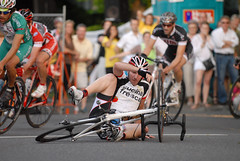
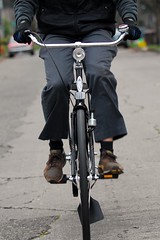
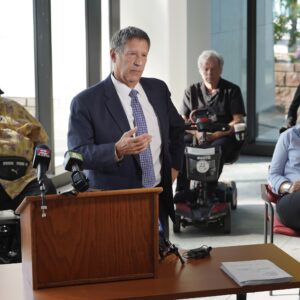
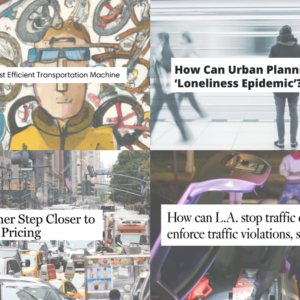
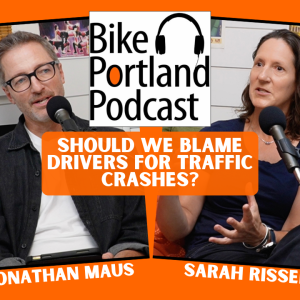
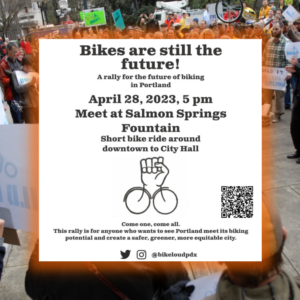
Thanks for reading.
BikePortland has served this community with independent community journalism since 2005. We rely on subscriptions from readers like you to survive. Your financial support is vital in keeping this valuable resource alive and well.
Please subscribe today to strengthen and expand our work.
So how about some tire recommendations for Portland streets and weather?
I always assumed narrow tires were faster… of course they don’t factor in wind resistance… but I never go over 25mph anyways…
@Spiffy: actually, in typical road conditions, narrow, high pressure tires can be slower, because you lose more forward momentum over bumpy surfaces (they bounce up more).
I’ve really liked the Schwalbe Marathons – fairly wide, I run them at about 65psi, and a good mix of fairly smooth down the middle of the tire, with more tread along the sides. Never had any traction issues with them (but I also ride relatively slow).
we’re not talking about weight of the tire right? because narrower tires are lighter and accelerate quicker, and can be inflated to higher pressures…i’d rather go with the fatter tire at lower pressure in slick conditions though…for the increased contact patch while cornering…bikeforums love the vectran gp4000S by continental, though pricey at retail…polyx gpS are the same compound at half the price(and maybe half the flat protection)
so which tires do best on pavement covered in wet mushy leaves?
I first heard that saying in reference to motorcycling, where it’s important to keep the rubber side down, and the shiny side up. I would have liked to see some more science around wet-weather braking techniques, and why it’s even more important in the rain & leaves to use your front brake effectively. I feel there’s a lot of mystery and avoidance of the front brake, when that is what will keep you safe.
Another important item about friction, and available traction, is that you only have so much of it. You use up traction while accelerating, braking and turning. If you’re in a turn and you try to brake, you can easily run out of our favorite coefficient and start sliding sideways. Brake before your turn, not in it, and straighten out before you hammer the pedals. Squeeze progressively on the brake. Never grab.
Unless you’re like me, and you enjoy fishtailing your Big Dummy through the wet leaves to leave a bit more traction for the next rider. You’re welcome, folks. 🙂
p.s. For the inevitable tire thread, I’ve had excellent wet and dry experiences both with Specialized Armadillo Elites 700Cx23 on my road bike, and Schwalbe Marathon Supreme 2.1’s on the Big Dummy. Flat-proof-ness cannot be overvalued.
while we’re at it let’s also mention brake pads…koolstop salmon pink colored pads are the standard for wet weather riding…and they won’t sand down your rims like normal compounds…koolstop is based in lake oswego…
on wet cornering…put as much weight on the outer pedal to lower your center of gravity…whatever you do, don’t yank the handlebars inside mid corner to tighten up a turn…that’s how falls occur…do most of your braking in a straight line before a corner
The explanation about wide tires running better leaves out one oh so important detail: Yes, in principle it is correct that a wide tire will run better than a more narrow one. However, this is based on the assumption (as we can easily see in the formula) that the tires are run at the same pressure. And you won’t (and shouldn’t) run a 57 mm Schwalbe Big Apple at the same pressure as a 23 mm racing tire.
So by all means, get wide tires. They’re more comfy and you won’t have any issues with pinch flats. But don’t assume that they’re going to make you faster.
Did the hydroplaning equation get lost?
Thanks for a great writeup.
#6
big dummy skidding! I ride my tandem(sans passenger) in the wet for the increased stability of having the rear wheel way out behind you…bikes with longer wheelbase slide really slow compared to normal bikes so ample warning before a fall…yeah, ride a tandem you big dummy
BURR: as far as I know, nothing. Same is true of wet metal or paint.
mello, it ain’t the brake pads themselves that wear down your rims; it’s the constant spray of gritty water from the wet road, coating both rims and pads and acting as an abrasive slurry. Kool-Stop salmon are good, but they can’t prevent road spray.
true…but in the dry the salmon koolstops won’t wear down your rims like black pads
I often see people with single speed, non-coaster brake bikes which just have a front hand brake.
Could this be the solution to fishtailing?
also a fixed gear lets the rider feel traction in the wet and can slow the bike down without hand brakes…they’re also cheaper to maintain instead of having to remove road gunk from a shifting drive-train…no expensive shifters to corrode up either
Great article, and timely too. Thank you!
For riding on pavement covered with wet leaves, there is no ideal tire, though I’ve had good results with both the 26 x 1.75 Schwalbe Marathon and the 26 x 1.5 Panaracer Pasela. I run both at less-than full pressure year-round, and go a little lower still when the conditions are less than optimal.
As for the front brake — for most folks it is one of the most under-utilized parts of the bike. Which is a shame, because it can provide up to 70% of the bike’s stopping power. Learn to use the front brake more — give yourself more distance and time to stop so you can learn to ease into the front brake, then overlap with gradual pressure on the rear.
#14 Daniel, no that’s the solution to overpopulation. I love seeing people who copied the “fixie” look with no rear brake, and then realized they missed coasting and slapped a freewheel on the back. Genius.
@ #12: Brake pads can and do wear down your rims. Over the last ten years I have purchased two new bikes that came with Shimano brake pads marked ‘for alloy rims’. These brake pads are actually manufactured with little bits of aluminum imbedded in the rubber and you can actually hear them destroying your rims when you brake.
“[NASA] found that it is primarily based upon the tire pressure and can be simplified by this equation.”
Where is this equation?
Dave #3, I know a few pro riders who would strongly disagree with you about tire size.
For those hunting the hydroplaning equation, follow the NASA link – it’s on page 5: V = 9 * P^.5
The V vs. p equation seems missing in the post.
I looked up the reference (given at the end of the post) and I believe the missing equation is on p. 5, eqn (4):
V = 9 * sqrt(p)
where p is in lb/(sq in)
and V is in knots.
This fits the two examples given in the post – remember to convert knots to mph (1 knot = 1.15 mph is mentioned in the post) to verify the example numbers given.
When it is wet out, leaves, painted sections of the road, sewer covers, metal grates all can be slick and as pointed out by other commentors, take it slow and brake before you go into the turn.
jeff #20 and Dave #3
Microjumping of high-pressure tires is a new topic of study and discussion. I haven’t been able to find any analytical data supporting either side of it yet though.
@Harald #8
You are spot on with your comment. I am playing with a wider rim/skinny high-pressure tire combination to see if I can measure any rolling resistance differences.
@mello yello @Over and Doubt
I am going to try and get Kool-Stop on board for a brake pad overview to help understand all the different compounds and verbiage.
-Shawn Small
I run Panaracer tires, and have had very good luck with them. Ruffy Tuffys and T-Serv Protex. I have also had pretty good luck with Continental Gatorskins, and 4 Seasons. Conti’s have gotten a little expensive though, and I think Panaracer is every bit as good, if not better. Check out biketiresdirect here in portland, they’re a great shop and have great prices!
The bike in the banner photo makes me feel like I had too much tequila…you know, all inside out and backward feeling…
Ed (#11): Definitely right about wet metal! I’ve got a Ti collarbone to show for it. This was in very light rain on 25mm Conti 4000S inflated to ~105. Otherwise they’ve been great, but I notice my Conti 4K and Gators lost softness fairly quickly. I’ve heard Schwalbe’s raved about for wet weather in many bike shops, including several where they were a less expensive option. Getting ready to pick up a set to throw on the winter wheels…
as Spock was wont to say, fascinating!
but i’m a bit confused – doesn’t the actual tire width figure in the equation calculating the contact patch? If so, I don’t see it.
—-
area of your contact patch:
A: is the area of the contact patch (inch2)
W: is the combined weight of the bike and the rider (lbs)
P: is the tire pressure (pounds/inch2)
W / P = A
—–
????
i guess this is what is not making sense to me:
“Because of the longer flattened area of the narrow tire, the wheel loses more of its “roundness” and produces more deformation during rotation. However, in the wide tire, the radial length of the flattened area is shorter, making the tire “rounder” and so it rolls better.”
i really don’t understand why this would be so. And yes, i can be obtuse, i know.
I thought the article was interesting and insightful but was surprised that there was no discussion of the difference between static and kinetic friction. Static friction refers to the traction between objects that are NOT sliding, and kinetic friction the traction when they are sliding. The static friction force is higher, which is why your stopping distance will be shorter if you brake smoothly at the threshold of your traction without skidding (skidding means you’re using kinetic friction which generates less force).
Friction itself is created by “coldwells,” which are microscopic valleys and peaks on the surface of objects that run into one another as objects slide. If you think of non-sliding objects as having these peaks and valleys interlocked, you can understand why static friction is greater than kinetic friction. Once you exceed static friction you’re out of the rut and sliding becomes easier. Knobby tires exaggerate this effect and make it visible, providing edges and corners on the tire surface to grip the travel surface just like the microscopic coldwells.
I also remember doing an experiment in high school physics class where we verified that total grip is not affected by contact area when the coefficient of friction and weight (or normal force) stay the same (because the force per area increases as the contact area decreases).
Also, as noted in Post 6, when cornering the total grip of your tire is divided two forces, one in the direction of travel and the other perpendicular to the direction of travel (aligned radially to the turn). The hypotenuse formed by these orthogonal vectors is equal to the total grip of the tire. Thus, when you corner it is easier to exceed the grip (static friction) in either the forward or perpendicular direction, resulting in a fish tail. Putting your weight on the outside pedal simply shifts your weight to increase the normal force on the road and the total available grip.
I like to run secret tires, with an unkowable contact patch/pressure rating. I find that this gives me the best ratio of performance to safey while keeping me one step ahead of wankish blog hounds. It’s also true that no tire can take the place of good judgement when facing winter riding conditions.
Hi bikieboy:
One way to think of it, is the 2d size of the contact patch for the narrow tire and wide tire are about the same for a given pressure.
In the narrow tire, the contact patch is oval shaped: narrower, longer, and deeper than the more round contact patch of the wider tire.
Tire rolling resistance comes from the bending of the rubber walls of the tire, since the narrow tire deforms more in a deeper indentation than the wide tire, the walls bends more than in the wider tire.
There is a similar story for tires on smaller diameter wheels. A 20 inch bmx or 26 inch mountain tire will have very slightly more rolling resistance than a 27 inch road tire at the same width and tire pressure.
Not that tire rolling resistance matters much in the big picture.
how about a story on knowing how to crash? as long as you are riding you will eventually crash and so many people are terrified of it. I was too, then i learned to love it! Sliding out in the wet leaves is hilarious, and frequently less painful than crashing dry.
Once you learn to crash, then you can learn to bike without fear. and knowing is half the battle.
Which tires operate well on wet roads aside, I prefer the flat protection provided by Schwalbe Marathon Plus (used to be called Smartguard). 2 x 28mm on my winter commuter at 80 PSI has served me reliably for the past five years, attaining a grand total of three flats which were all caused by stray screws and nails going through the sidewall. Not having to deal with flats in the rain is always preferable.
It’s easy to shoot down a fixie rider but #15 has a good point about the control a fixie gives in extremely slick conditions. A front brake becomes useless when even the lightest application will lock up the front wheel, leaving you without directional control and balance (and on the ground). By being able to feel with your muscles that point of maximum friction before the rear wheel locks up, you can provide optimal stopping power without endangering your safety. This is keeping in mind of course that your stopping distance is probably 3-4x or greater than normal. As an anecdote, I got caught in freezing fog a few years ago on my way to the Beaverton/Aloha area from downtown during early morning hours. Though the roads were empty, they were unexpectedly covered in ice and I was happy to be riding a fixie which was my main squeeze at the time. After a crash rather abruptly alerted me to the ice’s presence, I was able to ditch the front brake and make it home safe, albeit slow.
On my other bike I run 23mm at about 130 PSI, but it only goes out on sunny, dry days when I have a hankering for going fast.
Thanks for an informative article — one comment:
“The grooves or tread patterns on road tires are put on primarily for cosmetic reasons.”
Um, any city rider will encounter plenty of sketch conditions that will put their road tire tread to work —
* loose gravel (construction sites, de-icing)
* manhole covers and sewer drains — need the treat to catch on the iron nubs when you’re turning, otherwise you’ll slip out)
* leaves (need the grooves to let your tire’s rubber catch on the underlying pavement texture)
* rutted pavement, where studded tires have destroyed the driving surface you ride on slick pebbles embedded in concrete, need all the texture you can get in wet weather.
Ted Buehler
BURR #18: I’ve seen the metal flecks and heard the grinding myself, just as you reported–but those flecks most likely were grit-ground off your own rim and got stuck in the pads. Haven’t seen a metal-content pad (for rim brakes) since the “sinterized” Modolos that young Greg Lemond made cool for a while.
How’d the flecks get there already on new bikes? IDK. Test rides on wet days, maybe.
Beth H #16: 70% is a nice, round number for typical front-brake effectiveness of a good rider under normal, relaxed riding conditions. When you say “it can provide up to…” then the figure becomes 100%, as in a “stoppie” or extreme braking with rear-wheel lift-off. Anyway, agreed that front brakes rock.
Howdy–
That’s a great article, with some good insights. I’d include this link at the end:
http://www.vintagebicyclepress.com/images/TireDrop.pdf
This one provides some excellent advice for finding your own perfect tire pressure.
Happy Trails,
Ron G.
Corvallis
Vittoria Rrandonneur – First choice. Reflective sidewalls, Great tread, Durable
Panasonic RiBMO – Second choice.
Great shape, very tacky, a little heavy – but very durable
Go Phil!
OK, my contact patch on the road bike
(210 combined weight, 115psi) is
> 210/115
[1] 1.826087
My contact patch on the Mtn bike (at least 5 lbs heavier, at 55psi)
> 215/55
[1] 3.909091
yep, less rolling resistance on the road bike.
Winter?
700×25 German made Continental Grand Prix’s……..
Nuff said.
And the control one can get on a fixed gear in the rain is choice. Smoother than rim or disc braking. IMO
Without a redundant brake.
Like spreading butter on toast….
@bikieboy #27
You can move the values around in the equation based on what you know for data.
Since you know your total weight (W)lbs and your tire pressure (P)lbs/inch^2 you calculate (A) which is inch^2.
If you wanted to roughly estimate the shape of your contact patch assume it has a rectangle shape. The area of a rectangle is calculated by the length times the width A = W*L. Now that we know our A value and the tire width (28 mm ~ 1.10 inch) we can estimate the L value.
@ED #31 perfectly explained with the 2d idea
@Patrick #29
sounds like you are a tribology fan!
@Ted Buehler
Most commuter/road/touring tires don’t have enough tread to make much difference.
@John Campbell
At high speeds the stopping power of a hydraulic disc brake is far superior to anyones muscles.
BURR #18: I’ve seen the metal flecks and heard the grinding myself, just as you reported–but those flecks most likely were grit-ground off your own rim and got stuck in the pads. Haven’t seen a metal-content pad (for rim brakes) since the “sinterized” Modolos that young Greg Lemond made cool for a while.
How’d the flecks get there already on new bikes? IDK. Test rides on wet days, maybe.
I’m sorry, but I’ve been told this before and you are wrong.
I cleaned all 8 pads up after I removed them and examined them closely. There were large chunks of aluminum imbedded in the pads to a significant depth. It was definitely molded into the pads and not material from my rims or from the road.
I’ve replaced them with normal rubber pads and the problem has definitely not reoccurred.
As for the details, one of the bikes was a 2001 Batavus B1 hybrid and the other was a 2008 Dahon Vitesse.
All 8 aluminized brake pads were marked ‘for alloy wheels’ and manufactured by Shitmano.
Here is another Jan Heine link from his blog:
http://janheine.wordpress.com/2010/10/18/science-and-bicycles-1-tires-and-pressure/
Car brake pads also have bits of steel embedded in them. Ceramic pads have copper. I heard the salmon koolstop pads have iron oxide(aka rust). It seems metal is necessary in any type of brake pad.
“@John Campbell
At high speeds the stopping power of a hydraulic disc brake is far superior to anyones muscles.”
Spare Wheel,
It is not just about stopping power. well I mean it is if you are using a disc brake. Yank the lever, you’ll get stopped.
But when you are using your leg as a brake as the direct drive allows you to do, it is more about modulation, or IMO applying what you need to, when you need to, to what you need to.
You can feel in your legs, or more your whole body, what the tire, or more precisely, the contact patch, is doing on the street.
And make any number of changes to that with
minor or major changes to your attitude in relation to the bicycle.
So, in conclusion, while the actual “stopping power” of a disc brake may be far superior to that of the leg, a disc brake in no way is superior to the leg, applied as a brake on a fixed gear, in terms of versatility.
And versatility is what it takes to make it through a NW winter…..
burr, you are wrong.